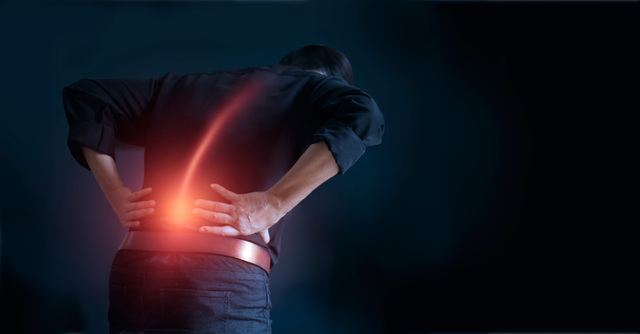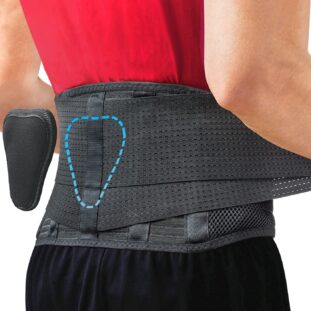Providing relief for chronic back pain often involves a combination of self-care strategies and professional interventions so it is still important to consult with your healthcare professional for personalized advice.
This article explores what you can do when you need relief for chronic back pain to be ache free. Options include purchased solutions, targeted exercises, posture control and doctor recommended solutions.
Keep in mind that not all immediate solutions will work the same for everyone because the nature of the back pain and degree of severity will differ.
Other solutions like acupuncture or chiropractic treatment should be recommended by a healthcare professional
Relief for Chronic Back Pain – Purchased Solutions
Heat and Cold Therapy
Apply heat pads or take warm baths to relax muscles and improve blood flow. Cold packs can help reduce inflammation and numb the area. Alternate between heat and cold as needed.
Heat and cold therapy are effective modalities for relief from chronic back pain. Applying heat to the affected area, through hot packs or warm baths, enhances blood flow, promoting muscle relaxation and reducing stiffness.
This method is especially beneficial for easing chronic muscle spasms.
On the other hand, cold therapy, achieved with ice packs, helps alleviate inflammation and numb the pain, offering a numbing effect on the sore region.
The alternating use of heat and cold can be a powerful strategy in managing persistent back pain symptoms. These therapies are easily accessible and can be applied at home, making them convenient and valuable components of a holistic approach to finding relief for chronic back pain.
Over-the-Counter Pain Medications
Non-prescription pain relievers, such as acetaminophen or nonsteroidal anti-inflammatory drugs (NSAIDs) like ibuprofen, may help manage pain and reduce inflammation.
Prescription medications, muscle relaxants, or nerve pain medications may also be prescribed by a healthcare professional.
This option is generally not recommended without fully understanding the cause of the back pain as you should NOT self medicate, Consult with a healthcare professional and follow recommended dosage.
Do not be tempted to increase the frequency of use of these pain medications if you do not experience the anticipated relief. Rather, return back to your healthcare professional for guidance.
Topical Analgesics

Topical analgesics play a significant role in providing relief for chronic back pain. These over-the-counter creams, gels, or patches contain active ingredients like menthol or NSAIDs, which are absorbed through the skin to target pain directly.
Applying these topicals to the affected area offers localized relief, reducing inflammation and temporarily blocking pain signals.
This method is convenient, as it allows you to manage your pain without relying solely on oral medications.
Topical analgesics are a valuable addition to a comprehensive pain management strategy, offering a targeted and practical solution for those seeking effective relief for chronic back pain.
Finding one that works for you may take time as there are a lot of topical analgesics on the market that are not as effective as they claim to be. A few of the more highly rated products are provided below. Check them out.
Relief for Chronic Back Pain – Targeted Exercises
Stretching and Strengthening Exercise
Perform gentle stretching exercises to improve flexibility and strengthen the muscles supporting the spine. Focus on exercises that target the core and back muscles such as yoga or Pilates.
Engaging in regular stretching and strengthening exercises is a fundamental component of finding relief for chronic back pain. These exercises focus on enhancing flexibility and building strength in the muscles supporting the spine.
Targeted stretches help alleviate tension and improve the range of motion, while strengthening exercises contribute to the stability of the back. Incorporating exercises that specifically target the core muscles is particularly beneficial for providing support to the spine and reducing strain.
A well-rounded exercise routine not only helps manage existing pain but also acts as a preventive measure against future episodes. Regular commitment to these exercises can contribute significantly to achieving sustainable relief for chronic back pain.
LOWER BACK PAIN RELIEF EXERCISES THAT WORK on You TUBE
Mind-Body Techniques
Practice relaxation techniques such as deep breathing, meditation, or mindfulness to help manage stress and reduce muscle tension
Mind-body techniques offer a holistic approach to finding relief for chronic back pain. Practices such as deep breathing, meditation, and guided imagery contribute to both physical and mental well-being.
These techniques help reduce stress, which can exacerbate back pain, and promote relaxation, easing tension in the muscles.
Mindfulness-based stress reduction (MBSR) and cognitive-behavioral therapy (CBT) are examples of therapeutic approaches that address the psychological aspects of chronic pain, fostering a positive mindset and coping strategies.
Relief for Chronic Back Pain – Posture Control
Supportive Pillows and Mattresses
Choosing supportive pillows and mattresses is key if you are truly looking at a longer term solution in the pursuit of relief for chronic back pain. A mattress and pillows that offer proper spinal alignment play a key role in reducing pressure on the back and supporting its natural curvature.
It is pointless to explore different solutions and at the end of the day return to a mattress and pillows that continue to create a misalignment of your spine!
Memory foam or latex mattresses, as well as pillows designed to maintain neck and spine alignment, are popular choices. When lying down, these supportive elements promote a neutral spine position, minimizing stress on the lower back.
People with chronic back pain should consider investing in ergonomic sleep accessories such as orthopedic pillows to ensure a restful and pain-free night’s sleep.
- Top Rated Orthopedic Pillows for Neck Pain – The Best Options
- Special Pillows for Neck Pain – Not Orthopedic
By providing adequate support during sleep, these accessories contribute to overall spinal health and aid in the ongoing effort to find effective relief for chronic back pain.
Posture Correction
Be mindful of your posture during daily activities. Sit and stand with proper spinal alignment, and avoid prolonged periods of sitting or standing in one position.
Ensure your workspace and living environment are ergonomically designed to support good posture.
Posture correction is key when seeking relief for chronic back pain. Maintaining proper posture throughout daily activities helps distribute the load on the spine evenly, reducing strain on the back muscles and ligaments.
Whether sitting, standing, or walking, being mindful of posture promotes spinal alignment. Sit with the back straight, shoulders relaxed, and feet flat on the ground.
When standing, distribute your weight evenly on both feet, and avoid prolonged periods of standing in one position. Regularly checking and adjusting posture during activities can contribute significantly to alleviating chronic back pain.
Also, incorporating posture-improving exercises into daily routines, such as shoulder rolls and gentle stretches, can further enhance the effectiveness of posture correction in the ongoing quest for relief from chronic back pain.
Weight Management
Maintain a healthy weight to reduce strain on the spine and supporting structures. Excess body weight can contribute to back pain, especially in the lower back.
By adopting a healthy and balanced diet along with regular physical activity, you can manage your weight effectively, reducing the load on the spine and minimizing strain on the back muscles.
Weight management not only addresses the root cause of some back pain but also enhances overall well-being. Shedding excess pounds can lead to improved mobility, decreased inflammation, and a more resilient spine.
Embracing a healthy lifestyle that includes a well-balanced diet and regular exercise is a proactive approach to finding lasting relief for chronic back pain, contributing to an improved quality of life.
Relief for Chronic Back Pain – Doctor Recommended Solutions
Acupuncture or Chiropractic Care
Some people find relief from chronic back pain through alternative therapies like acupuncture or chiropractic adjustments. Consult with a qualified practitioner to determine if these treatments are suitable for you.
Always consult with a healthcare professional before starting any new treatment or exercise regimen, especially if you have chronic back pain. Additionally, if your back pain persists or worsens, seek prompt medical attention to identify and address any underlying issues.
Massage Therapy
Regular massages can help relax tense muscles and improve circulation, providing relief from chronic back pain.
Massage therapy is generally considered safe for chronic back pain when performed by a trained and qualified massage therapist. However, it is essential to keep a few considerations in mind:
a. Before starting massage therapy, consult with your healthcare provider, especially if you have any underlying health conditions or concerns. They can provide guidance on whether massage therapy is suitable for your specific situation.
b. Seek a licensed and experienced massage therapist who has expertise in treating individuals with chronic back pain. A qualified professional will assess your condition and tailor the massage techniques to your specific needs.
c. Different massage techniques exist, such as Swedish massage, deep tissue massage, or trigger point therapy. Discuss your preferences and any sensitivities with the massage therapist to ensure the chosen technique aligns with your comfort level and pain tolerance.
Provide feedback to the massage therapist during the session. If you experience discomfort or pain, communicate openly so that adjustments can be made to the pressure or technique.
d. It is common to experience some soreness after a massage, especially if it involves deep tissue work. This is usually temporary and may be followed by pain relief and increased flexibility.
Contraindications
In certain situations, massage therapy may not be recommended, such as in the presence of acute injuries, infections, or certain medical conditions. Always inform the massage therapist about your health history and any existing conditions.
While massage therapy can be a valuable component of a comprehensive approach to managing chronic back pain, it’s important to integrate it into an overall treatment plan that may include other therapies, exercises, and lifestyle modifications.
Conclusion – How to Manage Chronic Back Pain for Quick Relief
Remember that the effectiveness of these quicker relief for chronic back pain strategies can vary from person to person, so, it is important to work closely with healthcare professionals.
They will help you identify the most suitable approach for your specific situation. If your back pain persists or worsens at any time, always seek prompt medical attention.
We would love to hear your story. Please leave a comment to share your chronic back pain story and any tips you employed to help alleviate the pain.
Related Articles
- 10 Causes of Lower Back Pain in Seniors – Facts
- How to Prevent Chronic Back Pain – 12 Ways
- Why Is Water Important to Your Health? – Facts To Know
- Poor Balance in Seniors – Why Oh Why?
- Improve Posture in Seniors – A Simple Mobility Trick
- Shoes for Sciatic Nerve Pain Sufferers – 9 Tips
FAQ – Relief for Chronic Back Pain
What are the most effective treatments for chronic back pain?
Treatment options include physical therapy, exercise, medication (such as NSAIDs or muscle relaxants), and interventions like epidural steroid injections or surgery in severe cases.
Are there natural remedies for chronic back pain?
Yes, natural remedies like yoga, acupuncture, massage therapy, and heat/cold therapy can help alleviate chronic back pain. Maintaining good posture and a healthy weight are also beneficial.
How can I prevent chronic back pain from worsening?
Regular exercise to strengthen core muscles, proper lifting techniques, maintaining a healthy weight, and ergonomic adjustments to workspace or sleeping positions can help prevent chronic back pain from worsening.
References
John Hopkins Medicine (2023) 7 Ways to Treat Chronic Back Pain Without Surgery https://www.hopkinsmedicine.org/health/conditions-and-diseases/back-pain/7-ways-to-treat-chronic-back-pain-without-surgery




